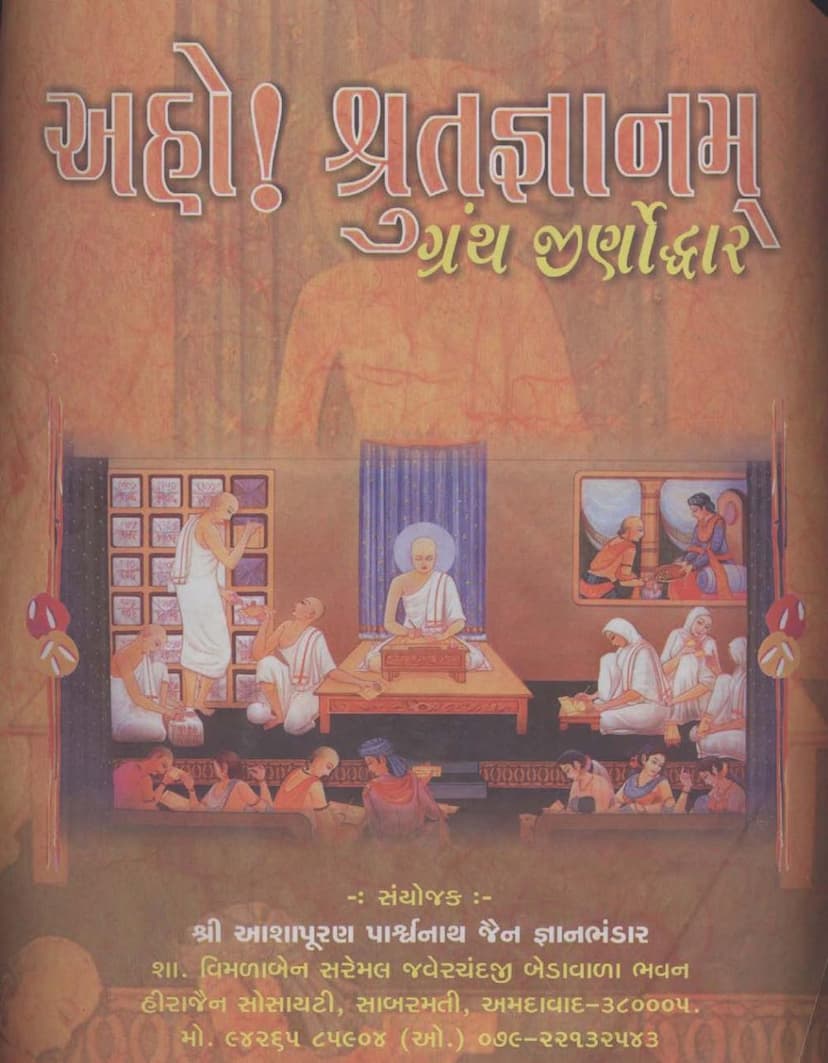Radhanpur Pratima Lekh Sanodha
Added to library: September 2, 2025

Summary
This is a comprehensive summary of the Jain text "Radhanpur Pratima Lekh Sanodha" by Vishalvijay, published by Yashovijay Jain Granthmala.
Book Title: Radhanpur Pratima Lekh Sanodha (Collection of Inscriptions on Idols from Radhanpur) Author: Vishalvijay (credited as Muni Vishalvijay / Dharmjayant Pasak Muni Vishalvijay) Publisher: Yashovijay Jain Granthmala Catalog Link: https://jainqq.org/explore/009683/1
Overall Summary:
The book "Radhanpur Pratima Lekh Sanodha" is a significant compilation of inscriptions found on Jain idols and temple structures in Radhanpur, Gujarat. It meticulously documents the historical and religious significance of these inscriptions, providing valuable insights into Jain art, architecture, history, and the lineage of monks and patrons. The work is a result of extensive research and collection efforts, aiming to preserve this crucial historical data.
Key Aspects and Content:
-
Introduction and Purpose:
- The book was compiled and edited by Muni Vishalvijay, who was inspired by his gurus and had a keen interest in history and archaeology.
- The primary purpose was to collect and preserve the inscriptions from the numerous Jain temples in Radhanpur, which were considered vital for understanding the region's history and the Jain community's past.
- The publisher, Yashovijay Jain Granthmala, highlights the importance of such epigraphical collections for historical research, noting that while such publications may not be economically lucrative, they contribute immensely to knowledge.
-
Radhanpur's Historical and Religious Context:
- The book includes a section detailing the history and current state of Radhanpur, a significant Jain center.
- It mentions Radhanpur's geographical location and its past rulers.
- Crucially, it lists approximately 25 Jain temples in Radhanpur, providing brief descriptions and historical details about many of them, including their founding, deities, and notable features.
-
Inscriptions (Pratima Lekh):
- The core of the book is the detailed listing and transcription of inscriptions found on Jain idols and temple inscriptions.
- These inscriptions typically include:
- Samvat (Year): The Jain or Vikram era year of the idol's creation or consecration.
- Tithi (Date): The specific day and lunar phase.
- Details of the Idol: The deity depicted (e.g., Parshvanath, Shantinath, Adinath, Mahavir Swami, Kunthunath, Chandraprabhu, etc.), often mentioning the Tirth (set of three idols), Panchtirthi (set of five), or Chaturvishati (set of 24 Tirthankaras).
- Donor Information: The names of the individuals, families, or groups who commissioned the idol or its installation. This often includes lineage details, business affiliations (like Shah, Seth, Vyapari, Dosi), and place of origin.
- Gachchha and Acharya: The Jain monastic lineage (Gachchha) and the specific Acharya or Guru under whose guidance the consecration took place. This is a recurring and important piece of information for understanding sectarian affiliations.
- Purpose of Donation: Often stated as "Atmanah Shreyase" (for one's own welfare), "Pitru-Matri Shreyase" (for parents' welfare), or for the welfare of other family members or the community.
- Location: The specific temple or area within Radhanpur where the idol or inscription was found.
- The inscriptions span a considerable period, from the 11th century (Samvat 1110) to the 19th century (Samvat 1893 and later), offering a chronological view of Jain activity in Radhanpur.
- The book categorizes these inscriptions and presents them numerically, along with the transcribed text and a translation or summary, often in Gujarati.
-
Appendices and Supporting Material:
- List of "Aho Shrut Gyanam" Books: A significant portion of the book (pages 4-9) is a catalog listing many other Jain religious and historical texts that were part of the "Aho Shrut Gyanam" series, indicating the broad scope of the publisher's work.
- List of Supporters: The book acknowledges financial supporters for the "Aho Shrut Gyanam" project and for this specific publication, highlighting community involvement.
- Prakashkiya Nivedan (Publisher's Note): This section emphasizes the importance of inscriptions for historical research and the need for further efforts in this area. It also traces the lineage of similar epigraphical collections published by the same organization.
- Author's Preface (Kinchit Vaktavya): Muni Vishalvijay shares his personal journey of collecting these inscriptions, his initial intent, and his gratitude to those who helped in the publication.
- Appendices (Parishisht): These include:
- List of Tirthankaras: A list of Tirthankaras mentioned in the inscriptions.
- List of Acharyas and Monks: A compilation of the names of Jain spiritual leaders associated with the inscriptions and their lineages.
- List of Dynasties and Villages: Mentions of various clans and places relevant to the inscriptions.
- Stavans (Hymns/Praise Songs): Several devotional hymns related to Radhanpur's deities (like Godi Parshvanath, Shant humanity), offering lyrical insights into the religious practices and sentiments of the time.
- Songs and Poems: Including a "Rathyatra Song" and a "Jivdaya Gita" (Song on Compassion for Living Beings), which provide cultural and moral context.
- Prarthana Shatak: A collection of prayers dedicated to Lord Mahavir.
Significance:
- Historical Resource: The book serves as an invaluable primary source for scholars of Jainism, Indian history, epigraphy, and art history.
- Preservation of Knowledge: It helps in preserving the historical data embedded in these inscriptions, which might otherwise be lost due to the passage of time or deterioration.
- Genealogical and Lineage Information: The details about patrons and monks provide crucial information for tracing genealogical lines and the spread of specific Jain traditions and Gachchhas.
- Religious and Cultural Insight: The inscriptions and the accompanying historical context offer a glimpse into the religious fervor, devotional practices, and community support for Jainism in Radhanpur over centuries.
- Archival Value: It acts as an archive of the numerous Jain temples and their artistic and devotional heritage in Radhanpur.
In essence, "Radhanpur Pratima Lekh Sanodha" is a meticulous and scholarly work that brings to light the rich epigraphical heritage of Radhanpur, contributing significantly to the study and appreciation of Jain heritage.